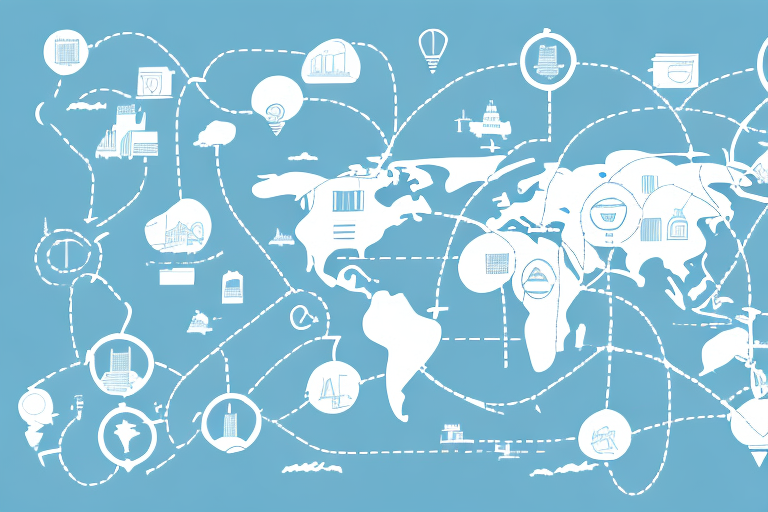Understanding Country of Origin Marking in the Supply Chain
As businesses expand their operations globally, they must navigate various legal and regulatory requirements, one of which is country of origin marking. In this article, we will explore the importance of country of origin marking in the supply chain, legal requirements, benefits, challenges, best practices, and future trends.
Why Country of Origin Marking is Important in the Supply Chain
Country of origin marking is crucial for several reasons:
- Transparency and Traceability: It provides transparency and traceability in the supply chain. Customers and regulators can easily determine where products come from, which helps promote ethical sourcing and prevent counterfeiting. According to the World Customs Organization, accurate country of origin markings can significantly reduce fraud in international trade.
- Influence on Consumer Purchasing Decisions: Many consumers prefer products made in certain countries due to perceived quality and safety standards. A 2022 survey by Nielsen found that 65% of consumers are willing to pay more for products with transparent origin information.
- Impact on Trade Agreements and Tariffs: Some countries have preferential trade agreements with others, resulting in lower tariffs or other benefits for products originating from those countries. Accurate country of origin marking ensures these benefits are properly applied. For example, the United States-Mexico-Canada Agreement (USMCA) includes specific provisions on country of origin labeling.
- Cultural and Heritage Preservation: Certain products, such as traditional handicrafts or foods, may have a strong association with a particular country or region. Accurate country of origin marking helps preserve and promote these cultural traditions.
The Legal Requirements for Country of Origin Marking in the Supply Chain
The legal requirements for country of origin marking vary depending on the country of import and export. For instance:
- United States: The Tariff Act of 1930 requires marking of imported goods to indicate their country of origin. The Federal Trade Commission (FTC) also regulates the use of “Made in the USA” labels. Non-compliance can result in fines and reputational damage.
- Canada: The Customs Act mandates that imported goods be marked with their country of origin. Additionally, the Canadian government provides guidelines for using labels such as “Product of Canada” and “Made in Canada”.
- European Union: The EU has more complex rules on country of origin marking, which vary depending on the product type and the country of origin. Detailed regulations can be found in the EU Customs Regulations.
Compliance with these regulations is essential not only to avoid legal penalties but also to uphold consumer trust and protect intellectual property rights. Accurate country of origin marking can influence trade relations, promote domestic industries, and protect them from unfair foreign competition.
The Benefits of Accurate Country of Origin Marking for Businesses
Implementing accurate country of origin marking offers multiple benefits for businesses:
- Regulatory Compliance: Helps businesses stay compliant with legal requirements, avoiding fines and sanctions.
- Enhanced Reputation: Builds trust with customers who value transparency and ethical sourcing practices.
- Supply Chain Efficiency: Facilitates identification of cost-saving opportunities and improves overall supply chain management.
- Risk Mitigation: Assists in managing product recalls and liability claims by providing clear information about product origins.
- Informed Decision-Making: Enables businesses to prioritize suppliers and locations that offer the best quality and value.
Moreover, accurate country of origin marking supports sustainability initiatives and responsible sourcing, aligning with the growing consumer demand for ethically produced goods.
How to Determine the Country of Origin for Products in the Supply Chain
Determining the country of origin involves evaluating various factors, including manufacturing processes, sourcing of raw materials, and assembly locations. Businesses should follow these steps:
- Consult Customs Guidelines: Refer to the regulations provided by relevant customs agencies to understand criteria for determining country of origin.
- Collaborate with Suppliers: Work closely with suppliers to confirm the origin of raw materials and components.
- Maintain Detailed Documentation: Keep comprehensive records of the supply chain to support country of origin claims.
- Implement Traceability Systems: Use technology such as barcode scanners or RFID to track products throughout the supply chain.
Accurate determination is not only a legal requirement but also a critical component of building consumer trust. Mislabeling can lead to penalties, legal disputes, and damage to brand reputation.
Ensuring Compliance with Country of Origin Marking Regulations
To ensure compliance, businesses should:
- Understand Legal Requirements: Stay informed about the country-specific regulations governing country of origin marking.
- Implement Verification Processes: Establish procedures to verify the accuracy of country origin information, including regular audits.
- Train Employees: Educate staff about the importance of accurate labeling and the specifics of compliance.
- Collaborate with Suppliers: Ensure that suppliers adhere to country of origin marking standards and provide necessary documentation.
Compliance not only avoids legal repercussions but also strengthens customer trust and enhances overall business reputation. Regular audits and updates to compliance strategies are essential as regulations evolve.
Common Challenges and Pitfalls in Country of Origin Marking
Implementing country of origin marking can present several challenges:
- Miscommunication with Suppliers: Inaccurate information from suppliers can lead to incorrect labeling.
- Lack of Documentation: Insufficient records can hinder the ability to verify country of origin claims.
- Complex Labeling Requirements: Different countries have varying and sometimes conflicting labeling standards.
- Multiple Country Components: Products assembled from components sourced from multiple countries complicate origin determination.
To mitigate these issues, businesses should:
- Establish clear communication channels with all supply chain partners.
- Maintain comprehensive and accurate documentation.
- Stay updated with regulatory changes across different markets.
- Utilize technology solutions to manage and track origin information effectively.
Awareness of these challenges and proactive measures can prevent legal complications and preserve brand integrity.
Best Practices for Effective Country of Origin Marking in the Supply Chain
Adopting best practices can enhance the effectiveness of country of origin marking:
- Clear Labeling Standards: Define and standardize labeling requirements across all products and markets.
- Regular Audits: Conduct periodic audits to ensure compliance and identify areas for improvement.
- Technology Integration: Implement systems like blockchain or ERP software to track and verify origin information.
- Employee Training: Provide ongoing training to staff on the importance of accurate labeling and compliance protocols.
- Supplier Collaboration: Engage suppliers in compliance initiatives and ensure they understand and adhere to labeling standards.
Additionally, staying informed about industry trends and regulatory changes allows businesses to adapt swiftly and maintain compliance.
The Role of Technology in Streamlining Country of Origin Marking
Technology plays a pivotal role in simplifying and enhancing the accuracy of country of origin marking:
- Automation: Automates the labeling process, reducing human error and increasing efficiency.
- Artificial Intelligence (AI): Analyzes complex supply chain data to determine accurate country of origin information.
- Blockchain: Creates immutable records of a product's journey from origin to sale, enhancing transparency and trust.
For example, blockchain technology can provide consumers with a tamper-proof record of a product's origin, including details about its ingredients, manufacturing processes, and transportation. This level of transparency builds consumer confidence and supports ethical sourcing practices.
Implementing these technologies not only ensures compliance with regulatory requirements but also offers competitive advantages by improving supply chain visibility and operational efficiency.
Case Studies: Successful Implementation of Country of Origin Marking in the Supply Chain
Several companies have effectively integrated country of origin marking into their supply chains:
Nike
Nike employs a robust system to track the country of origin for each product. The company mandates that its suppliers adhere to strict ethical and environmental standards. Utilizing machine learning and data analytics, Nike enhances the accuracy and efficiency of its origin tracking processes, ensuring compliance and fostering consumer trust.
Patagonia
Patagonia, known for its outdoor clothing and gear, maintains a transparent supply chain by providing detailed information about the origin of their materials and products. The company prioritizes partnerships with suppliers who share its values of sustainability and fair labor practices, reinforcing its commitment to ethical sourcing.
Walmart
Walmart has implemented a comprehensive country of origin labeling program for its fresh produce. Suppliers are required to label the country of origin on each package, enabling customers to make informed purchasing decisions. Walmart conducts regular audits to ensure compliance with ethical and environmental standards, thereby maintaining high quality and transparency in its product offerings.
Future Trends and Developments in Country of Origin Marking
As global supply chains become increasingly complex, several trends are shaping the future of country of origin marking:
- Advanced Technology Adoption: Increased use of AI, blockchain, and IoT devices to enhance traceability and accuracy.
- Standardization of International Regulations: Efforts to harmonize country of origin labeling standards across different regions to facilitate smoother international trade.
- Enhanced Consumer Transparency: Growing demand for detailed product origin information, potentially including specific regions or even individual farms.
- Sustainability and Ethical Sourcing: Greater emphasis on the environmental and social impact of products, driving stricter origin verification processes.
These developments indicate a move towards more transparent, efficient, and consumer-centric country of origin marking practices. Businesses that adapt to these trends will likely gain a competitive edge in the global marketplace.
Conclusion: The Importance of Compliance with Country of Origin Marking Regulations
Compliance with country of origin marking regulations is essential for businesses operating on a global scale. Accurate marking enhances transparency, promotes ethical sourcing, and improves supply chain efficiency. By adhering to best practices and leveraging advanced technology solutions, businesses can ensure compliance and benefit from effective country of origin marking.
Furthermore, compliance helps businesses avoid legal penalties and protect their reputation. Non-compliance can lead to fines, product recalls, and legal actions, which can severely damage a company's standing in the market. With consumers increasingly valuing ethical sourcing and transparency, adhering to country of origin regulations is not just a legal obligation but also a strategic business advantage.
Effective country of origin marking differentiates businesses from competitors, fosters customer loyalty, and can lead to increased profitability. As global trade continues to evolve, maintaining rigorous standards in country of origin labeling will remain a critical component of successful and responsible business operations.






















